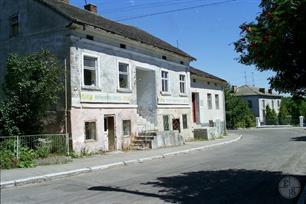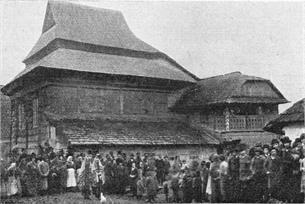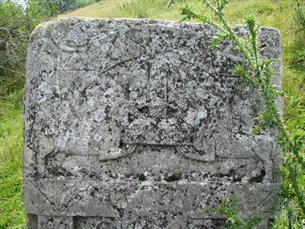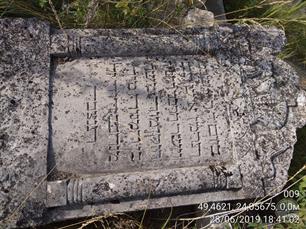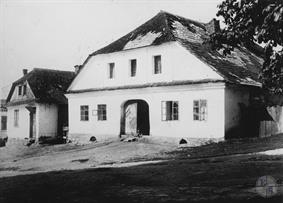Rozdil
Stryy district, Lviv region
Sources:
- Russian Jewish encyclopedia
- Mayer Balaban, Jewish encyclopedia of Brockhaus & Efron
- Virtual Shtetl. Rozdoł
Photo:
- Jewish Cemeteries Initiative. Rozdil Jewish Cemetery
- Vladimir Levin, Boris Khaimovich: Center for Jewish art. Rozdil (Razdol, Rozdoł)
- Biblioteka Narodowa Polona. Rozdoł
- Wikipedia. Palace in Rozdil
- Сергій Хом'як. Синагога y Роздолі
- Andy Travel Club. Розділ
- Facebook Rozdil Palace
- Russian Jewish encyclopedia
- Mayer Balaban, Jewish encyclopedia of Brockhaus & Efron
- Virtual Shtetl. Rozdoł
Photo:
- Jewish Cemeteries Initiative. Rozdil Jewish Cemetery
- Vladimir Levin, Boris Khaimovich: Center for Jewish art. Rozdil (Razdol, Rozdoł)
- Biblioteka Narodowa Polona. Rozdoł
- Wikipedia. Palace in Rozdil
- Сергій Хом'як. Синагога y Роздолі
- Andy Travel Club. Розділ
- Facebook Rozdil Palace
Rozdil, urban -type village (since 1940) in Lviv region. It was founded in 1569. In the 16-18 centuries - in Lviv land of Russian governorship as part of the Commonwealth. In 19 - beginning 20th century - in province of Galicia in Austria-Hungary. In 1919–39 - in Stanislav Voivodeship as part of Poland, in 1939–91 - as part of Ukrainian SSR.
In 1765, 639 Jews lived in Rozdil,
in 1880 - 2465 (54.3%),
in 1890 - 2277 (52%),
in 1900 - 2262 (48.8%),
in 1910 - 2110 (45.9%),
in 1912 - 2262 (48.7%),
in 1921 - 1725 (45.4%),
In 1931 - 1902 Jews.
In 1765, 639 Jews lived in Rozdil,
in 1880 - 2465 (54.3%),
in 1890 - 2277 (52%),
in 1900 - 2262 (48.8%),
in 1910 - 2110 (45.9%),
in 1912 - 2262 (48.7%),
in 1921 - 1725 (45.4%),
In 1931 - 1902 Jews.
Rabbi of Rozdil at the end of the 17th century. was Moishe Levy, at the end of the 17th - early 18th centuries - Moishe Ashkenazi, at the end of the 18th century - Osher-Anshel Ashkenazi (1740–1793), Chaim Rapoport (1776–1799), in the early 19th century -Moishe Ginzburg (? –1805), Moishe-Dovid Ashkenazi (? –1814), then - the son of the last Gershon (? –1819).
Rabbi in Rozdil at the end of the 19th century - Alexander-Sender Segal (1815–1902).
In the first part of the 19th century, a Hasidic court was founded by Yehuda-Zvi Eichenstein (1791–1847).
In 1886, a Hasidic court was also founded by Pinhos-Haim Taub (1867–1935).
Rabbi in Rozdil at the end of the 19th century - Alexander-Sender Segal (1815–1902).
In the first part of the 19th century, a Hasidic court was founded by Yehuda-Zvi Eichenstein (1791–1847).
In 1886, a Hasidic court was also founded by Pinhos-Haim Taub (1867–1935).
Jews traded at fairs not only in the town, but also in nearby villages. They were selling in particular decorative beads, which were part of the traditional Ukrainian costume.
At the beginning of the 20th century, Hasidism was gaining popularity, and the number of followers kept on increasing in the interwar period.
Since 1912, Zionist organizations began to operate in Rozdil.
In 1916, 16 Jews were sent from Rozdil to Tarnopol (modern Ternopil).
In the 1920-30s there were branches of various Jewish parties and organizations. A school worked with teaching in Hebrew.
In 1927 a new synagogue was built.
Rabbi of Rozdil in the 1930s - Matthiyagu-Aron Eichenstein (? –1942).
At the beginning of the 20th century, Hasidism was gaining popularity, and the number of followers kept on increasing in the interwar period.
Since 1912, Zionist organizations began to operate in Rozdil.
In 1916, 16 Jews were sent from Rozdil to Tarnopol (modern Ternopil).
In the 1920-30s there were branches of various Jewish parties and organizations. A school worked with teaching in Hebrew.
In 1927 a new synagogue was built.
Rabbi of Rozdil in the 1930s - Matthiyagu-Aron Eichenstein (? –1942).
In June 1941, Nazi forces occupied Rozdil. A ghetto was set up in the town, where about 1,500 Jews were murdered by the end of July 1942.
Between 4 and 5 September 1942, about 1,000 remaining Jews were deported to the extermination camp in Bełżec.
Between 4 and 5 September 1942, about 1,000 remaining Jews were deported to the extermination camp in Bełżec.
 |
 |
 |
| Palace of Lanckoronsky in Rozdil, 2013 | Palace of Lanckoronsky in Rozdil, before 1930 | Postcard printed in Rozdil, 1928 |
Jewish cemetery in Rozdil, 1995
Jewish cemetery in Rozdil, 2011
Jewish cemetery in Rozdil, 2019
The earliest records mentioning Jews in Rozdуł date back to beginning of the 17th century.
Then a community was created, a wooden synagogue (burned in 1907) was built. In 1628 Jews belonged to 2 houses. There was a heder.
In the 18th century the town belonged to Rzhevusky, who led a long-term dispute with the Russian-Bratslav region (Medinah) regarding the increase in taxes from Jews of its towns in the distribution of universal tax. In 1751, the case was understood by the Scarba Commission in Radom, which decided in favor of Rzhevusky.
According to Yakov Emden, Israel Baalshem, a rabbi in Rozdil, had to participate in the dispute of 1751. This led the famous historian Heinrich (Hirsh) Graetz to the idea that Israel Baal Shem Tov from Medzhibozh is identical to the rabbi in Rozdil, and that the Creator of Hasidism was an official rabbi in this town. But the local tradition knows nothing about this.
In 1880, 2,465 Jews lived in the town - the largest number in its entire history, approximately 54 percent of its population (4,542).
In the same year, there was a huge fire in Rozdił. The destruction it caused prompted many Rozdił Jews from to emigrate. This trend continued after the end of the World War I.
In 1921, the number of Jews living in Rozdуł decreased to 1,725 people.
Then a community was created, a wooden synagogue (burned in 1907) was built. In 1628 Jews belonged to 2 houses. There was a heder.
In the 18th century the town belonged to Rzhevusky, who led a long-term dispute with the Russian-Bratslav region (Medinah) regarding the increase in taxes from Jews of its towns in the distribution of universal tax. In 1751, the case was understood by the Scarba Commission in Radom, which decided in favor of Rzhevusky.
According to Yakov Emden, Israel Baalshem, a rabbi in Rozdil, had to participate in the dispute of 1751. This led the famous historian Heinrich (Hirsh) Graetz to the idea that Israel Baal Shem Tov from Medzhibozh is identical to the rabbi in Rozdil, and that the Creator of Hasidism was an official rabbi in this town. But the local tradition knows nothing about this.
In 1880, 2,465 Jews lived in the town - the largest number in its entire history, approximately 54 percent of its population (4,542).
In the same year, there was a huge fire in Rozdił. The destruction it caused prompted many Rozdił Jews from to emigrate. This trend continued after the end of the World War I.
In 1921, the number of Jews living in Rozdуł decreased to 1,725 people.

- Home
- Shtetls
- Vinnytsia region
- Volyn region
- Dnipro region
- Donetsk region
- Zhytomyr region
- Zakarpattia region
- Zaporizhzhia region
- Ivano-Frankivsk region
- Kyiv region
- Kropyvnytskyi region
- Luhansk region
- Lviv region
- Mykolayiv region
- Odessa region
- Poltava region
- Rivne region
- Sumy region
- Ternopil region
- Kharkiv region
- Kherson region
- Khmelnytskyi region
- Chernihiv region
- Chernivtsi region
- Cherkasy region
- Crimea
- Synagogues
- Cemeteries
- Objects & guides
- Old photos
- History
- Contact
Jewish towns of Ukraine
Jewish towns of Ukraine
My shtetl
My shtetl
Donate

